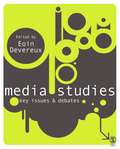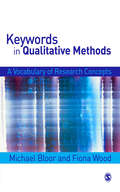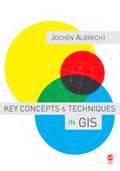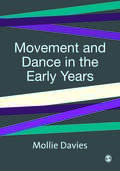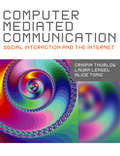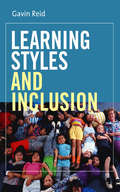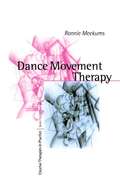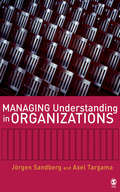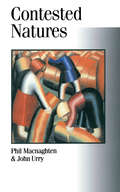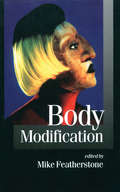- Table View
- List View
Neurobiology of Steroids (Methods in Neurosciences #Volume 22)
by E. Ronald de Kloet, Win SutantoSteroid hormones are unique compounds in that they are active at the interface of peripheral endocrine events and neural mechanisms. Thus their effects present an important peripheral signaling system to alter brain function. This volume presents state-of-the-art and classical techniques for the study of steroid hormones and their receptors and their effects and actions. - Comprehensive protocols included for the study of Steroid kinetics and metabolism - Steroid receptors - Molecular and cellular effects of steroids - Steroid effects on integrated systems
The Respiratory System: Basic science and clinical conditions (Systems of the Body)
by Andrew Davies Carl MooresThis is an integrated textbook on the respiratory system, covering the anatomy, physiology and biochemistry of the system, all presented in a clinically relevant context appropriate for the first two years of the medical student course. - One of the seven volumes in the Systems of the Body series. - Concise text covers the core anatomy, physiology and biochemistry in an integrated manner as required by system- and problem-based medical courses. - The basic science is presented in the clinical context in a way appropriate for the early part of the medical course. - There is a linked website providing self-assessment material ideal for examination preparation.
Media Studies: Key Issues and Debates
by Eoin DevereuxBringing together a range of renowned scholars in the field, this book examines eighteen key issues within contemporary media studies. Written in an accessible student-friendly style, Media Studies - Key Issues and Debates is an authoritative landmark text for undergraduate students. Each individual chapter begins with a concise definition of the concept(s) under investigation. This is followed by a 5,000 word discussion on the current state of play within research on the specific area. Chapters contain case-studies and illustrative materials from Europe, North America, Australasia and beyond. Each chapter concludes with annotated notes, which guide the student-reader in terms of future study. With a preface by Denis McQuail, contributors include Janet McCabe, John Corner, David Croteau, William Hoynes, Natalie Fenton, Jenny Kitzinger, Jeroen de Kloet, Liesbet van Zoonen, Sonia Livingstone and Greg Philo.
Doing Educational Research
by Clive Opie`A welcome and helpful addition to the shelves of tutors and students working on masters programmes. It will be most beneficial supporting students on programmes where there is a substantial research training component. It offers important exemplars of using computer software in qualitative analysis′ - Educational Review `This book is aimed at Master′s students who are engaging in educational research for the first time. [It] provides teacher-researchers with the additional information they need so they can go on to read further and more in depth, having more confidence in the accessibility of such studies. I found it does this well, and is an ideal point of reference for those who are just embarking on a Master′s degree. A useful glossary is provided, giving detailed but ′readable′ explanations of key terms and phrases′ - Primary Practice Doing Educational Research offers a hands-on guide for students engaged in educational research. It provides a comprehensive and accessible introduction to the key qualitative and quantitative methods necessary for those commencing research for the first time. Through a detailed yet concise explanation, the reader is shown how these methods work and how their outcomes may be interpreted. Providing all the essentials for the first-time researcher, the book includes: · a variety of examples and case studies to illustrate how the methods and techniques can be used in `real-life′ contexts · practical guidance on time management planning research projects and writing reports. · a broad coverage - including qualitative and quantitative methodologies, data analysis using computer software, ethical issues and the writing-up and presentation of data. This engaging book has been written by a team of leading researchers with over sixty years of cumulative experience. It has a student-friendly structure which will make it accessible and popular with undergraduates and postgraduates. It will be an invaluable resource for both students and researchers, helping them to undertake effective research in education.
Keywords in Qualitative Methods: A Vocabulary of Research Concepts
by Michael Bloor Fiona WoodAn essential companion for students across the social and health sciences, this text provides a wide-ranging coverage of qualitative methods complemented by extended illustration from the array of academic disciplines in which qualitative research is found and employed. Written in a lively and reader-friendly style, the guide covers a comprehensive range of topics, including: - a concise definition of the method - a description of distinctive features - examples to convey the flavour of a technique or principle - a critical and reflective evaluation of the method or approach under consideration - cross references to associated concepts within the dictionary - a list of key readings
Key Concepts and Techniques in GIS
by Jochen AlbrechtKey Concepts and Techniques in GIS is a concise overview of the fundamental ideas that inform geographic information science. It provides detailed descriptions of the concepts and techniques that anyone using GIS software must fully understand to analyse spatial data. Short and clearly focussed chapters provide explanations of: spatial relationships and spatial data the creation of digital data, the use and access of existing data, the combination of data the use of modelling techniques and the essential functions of map algebra spatial statistics and spatial analysis geocomputation - including discussion of neural networks, cellular automata, and agent-based modelling Illustrated throughout with explanatory figures, the text also includes a glossary, cross referenced to discussion in the text. Written very much from a user′s perspective, Key Concepts and Techniques in GIS is highly readable refresher course for intermediate level students and practitioners of GIS in the social and the natural sciences.
On Message: Communicating the Campaign
by Pippa Norris John Curtice David Sanders Margaret Scammell Holli A SemetkoTo what extent are the techniques of campaigning and media management critical to the outcome of modern elections? This book brings together a group of leading scholars to provide a comprehensive analysis of the role and impact of political communications during election campaigns. They set the context of election campaigning in Britain, and the methodology used to undertand media effects, review party strategies and resulting media coverage, and draw together evidence of the impact of the 1997 British General Election campaign, analyzing how far television and the press media influenced the public′s civic engagement, agenda priorities, and party preferences.
Real-Time Data Analytics for Large Scale Sensor Data (Advances in ubiquitous sensing applications for healthcare #Volume 6)
by Himansu Das Nilanjan Dey Valentina Emilia BalasReal-Time Data Analytics for Large-Scale Sensor Data covers the theory and applications of hardware platforms and architectures, the development of software methods, techniques and tools, applications, governance and adoption strategies for the use of massive sensor data in real-time data analytics. It presents the leading-edge research in the field and identifies future challenges in this fledging research area. The book captures the essence of real-time IoT based solutions that require a multidisciplinary approach for catering to on-the-fly processing, including methods for high performance stream processing, adaptively streaming adjustment, uncertainty handling, latency handling, and more. - Examines IoT applications, the design of real-time intelligent systems, and how to manage the rapid growth of the large volume of sensor data - Discusses intelligent management systems for applications such as healthcare, robotics and environment modeling - Provides a focused approach towards the design and implementation of real-time intelligent systems for the management of sensor data in large-scale environments
Movement and Dance in Early Childhood (Zero to Eight)
by Mollie Davies`This original and fascinating approach to children′s movement development is highly recommended reading for tutors, practitioner and students alike′ - Under Five `Movement and Dance in Early Childhood offers a clear and accessible entry into the world of movement and dance and the possibilities that exist for children, their families and the wider educational community′ - Every Child `Eminently readable and accessible. Whether the reader is versed in movement understanding or a beginner, by the end of the book they should be a much better movement observer, teacher and handler′ - Marion North, Principal and Chief Executive, Laban Centre for Movement and Dance In this unique and innovative book on movement and dance development from birth to eight years, the author draws on her depth of knowledge and practical experience in helping children to become skilled, creative and imaginative in a wide range of movement-oriented activities. The book seeks to help early childhood educators and parents in very practical ways and provides guidance based on a sound theoretical understanding. Originally published as Helping Children Learn Through a Movement Perspective, this book has been updated in the light of recent research. The author extends her investigation of how young children learn in and through movement. There is an expanded chapter on dance, which suggests strategies for working with young children and examines ways in which young children take on the roles of dance-makers, performers and appreciators. An additional chapter shows ways in which the expressive and artistic aspects of children′s movement can be appropriately located and includes exemplars for dance at Key Stage 1 and the early phases of Key Stage 2.
Leadership in Education (Centre for Educational Leadership and Management)
by Mark Brundrett Neil Burton Robert Smith`Leadership in education is receiving increasing attention, and this text contributes much to the debate. A useful text that will appeal to a wide audience of senior managers, teachers, programme designers and researchers′ - Learning and Skills Research `If one were on a fact-finding mission to gain insight into leadership thought and practice in education, then this book is an excellent resource′ - Education News `This book makes an excellent contribution to the current debate on Educational Leadership. It blends theory with practice and provides an important resource for many aspects of leadership development programmes at a variety of levels. The book will appeal to the academic reader, the postgraduate student and those involved in providing leadership courses at a professional level. There is an international perspective on the analysis of leadership theory and practice, integrating examples from a variety of cultural settings and exploring education at all phases from primary to higher′ - Stephen Merrill, Edge Hill College of Higher Education, Journal of In-Service Education `Leadership in Education offers an excellent analysis of the current debate: well informed on research and practice, positive but critical. It is particularly strong on what it calls "the railway-bookstall offerings of context-independent leadership"…. There is a great deal of practical wisdom within these very accessible pages′ - Michael Duffy, Times Educational Supplement This book deals with leadership in all sectors, from primary to higher education. It presents an international perspective on the analysis of leadership theory and practice, with the integration of exemplars from different cultural settings. The authors provide a wide range of conceptual perspectives on leadership. Themes include: - the efficacy of centralized versus distributed concepts of leadership - the contrast between competency and academic models of leadership development - the contradistinction between functionalist and democratic models of leadership. These themes are developed in four sections: - Conceptualization - Leadership development - Teachers as leaders - Leadership in practice Contributors include: Clive Dimmock, Peter Gronn, Marianne Coleman, Peter Ribbins, Ray Bolam, Peter Newton, Kenneth Leithwood, Helen Gunter, Lynn Davis, Clive Harber and Graham Peeke This book is recommended to all involved in educational management, particularly to students, teachers, researchers, policy makers and educational administrators. The Centre for Educational Leadership and Management series, edited by Tony Bush, examines the impact of the many changes in the management of schools and colleges, drawing on empirical evidence. The approach if analytical rather than descriptive and generates conclusions about the most effective ways of managing schools on the basis of research evidence.
Social Geographies: From Difference to Action
by Ruth PanelliHow do we describe ourselves? Where have we, do we, will we, live our lives? Why are the differences between people a source of tension? How can social change occur? Social geography can assist in addressing these questions. It provides ways of understanding and living in our contemporary world. Providing students with the resources to understand both the theoretical and empirical approaches social geographers take when investigating social difference, this text outlines key theoretical approaches and traces the core geographies of difference: class, gender, race/ethnicity, and sexuality. It concludes by showing how geographers work across these ideas of difference to understand questions of identity, power and action. Using illustrative examples from around the world, Social Geographies includes: - Individual chapters on the main theoretical approaches to difference - Individual chapters on the key concepts of identity, power and action - Reviews of the core literature, with suggestions for further reading - Biographies of key contemporary social geographers - Glossary of key terms For students beginning human geography courses, or in social geography modules, this book is the essential primer.
Computer Mediated Communication
by Crispin Thurlow Lara Lengel Alice TomicThis book offers students a task-based introduction to Computer-Mediated Communication and the impact of the internet on social interaction. Divided into four parts which require students to learn, (theory), critique, (current issues), explore, (methods), and reflect, (practice), the book aims to: Provide a foundation to the social and communicative nature of information and communication technologies Enable students to engage with the key theoretical issues associated with CMC Equip students with the necessary research and technical skills as a stimulus to independent enquiry. In spite of the rapidly increasing interest in Internet Studies and CMC and the introduction of many university courses in the area, no specialised, introductory textbook exists. This coursebook responds to the need for such a text. Aimed primarily at communication students, this book would also be useful as a sourcebook for students of media, sociology, psychology and English Language Studies. Companion website resources can be found at http://crispinthurlow.net/cmc/
Pediatric Anxiety Disorders
by Scott N. Compton Marianne A. Villabø Hanne KristensenPediatric Anxiety Disorders provides a critical, updated and comprehensive overview of anxiety disorders in children and adolescents based on the current state of empirical research. The book provides specific clinical recommendations which integrate new knowledge from neuroscience and innovative delivery formats for interventions. This is the first reference to examine anxiety diagnoses in accordance with the latest edition of the DSM-5, including childhood onset disorders, such as Separation Anxiety Disorder, Selective Mutism, Specific Phobia, Social Anxiety Disorder, Panic Disorder, Agoraphobia and Generalized Anxiety Disorder. The book assists clinicians in critically appraising the certainty of the evidence-base and the strength of clinical recommendations. - Uses the latest edition of the Diagnostic and Statistical Manual of Mental Disorders, the DSM-5 - Includes the Grading of Recommendations Assessment, Development and Evaluation (GRADE) approach in assessing guideline development - Focuses on advances in etiology, assessment and treatment - Presents new advances in our understanding of the brain behind fear and anxiety - Uses a stepped care approach to treatment
Travel and Tourism (SAGE Course Companions series)
by Richard SharpleyThe SAGE Course Companion in Travel and Tourism is an accessible introduction to the subject that will help readers extend their understanding of key concepts and enhance their thinking skills in line with course requirements. It provides support on how to revise for exams, how to present calculations and how to prepare for and write assessed pieces. Readers are encouraged not only to think like a Travel and Tourism professional but also to think about the subject critically. Designed to complement existing textbooks for the course, the companion provides: - Easy access to the key themes in Travel and Tourism and an overview of its business context - Helpful summaries of the approach taken by the main textbooks on the course - Guidance on the essential study skills required to pass the course - Sample exam questions and answers, with common pitfalls to avoid - A tutor′s-eye view of what course examiners are looking for - A road map for the book to help readers quickly find the information they need The SAGE Course Companion in Travel and Tourism is much more than a revision guide for undergraduates; it is an essential tool that will help readers take their course understanding to new levels and achieve success in their undergraduate course.
Learning Styles and Inclusion
by Gavin Reid′[Gavin Reid] provides some useful links to websites devoted to different approaches. Some of the ideas relating to specific areas of the curriculum, for example, the suggested approaches to the teaching of modern languages, are likely to be particularly valuable. Reid also outlines strategies using learning styles for pupils with learning differences, including attention disorders, dyslexia, developmental co-ordination difficulties, number difficulties, and those on the autistic spectrum′ - Times Educational Supplement Extra for Special Needs `We have been lucky enough to hear Gavin speak twice in the last year and those of you who have also heard him will know that he is at the cutting edge of his field. This book really encompasses those areas that are particularly topical and the "buzz" words on everyone′s lips! This book clearly sets out "who" is involved in inclusion and "what" is actually meant by learning styles. Gavin not only offers practical strategies but also suggests how "old hands" could vary their teaching styles to appeal to all types of learners. Therefore we feel this book is for the main stream teacher as well as the specialist and, if this is a target area for your school, this book might be a valuable addition to your bookshelf′ - SATIPS `In this book, Gavin Reid has grasped the nettle (of inclusion) with both hands and provided a text that is full of common sense and practical suggestions as to how the mainstream teacher can draw upon recent psychological theory and research to enhance the learning of all children. He jumps on no bandwagons but draws judiciously from a wide range of approaches to assessing learning styles and links what can be learned about groups and individuals from such techniques to helpful classroom practice′ - Professor Bob Burden, School of Education and Lifelong Learning, University of Exeter `Gavin Reid is that rare professional who not only explains how and why children learn best, but also suggests a myriad of practical strategies to help them. I highly recommend this book for everyone from undergraduates to "old hands" working toward successful inclusion. Parents, too, will profit from Dr. Reid′s wise and comprehensive experience′ - Jane M. Healy, Ph.D., Educational Psychologist and Author of "Your Child′s Growing Mind: Brain Development and Learning from Birth to Adolescence." 3rd Edition. NY: Broadway Books, 2004. Drawing on his considerable experience as a teacher, educational psychologist, lecturer and author, Gavin Reid illustrates how to assess pupils′ different learning styles and how to vary your teaching style to appeal to all types of learners, including disaffected students and those with special educational needs. This book provides an overview of the different stages in the learning cycle; describes the differences between learners; and emphasizes the role the classroom environment and different teaching styles play in children′s ability to learn. Readers will see how an understanding of learning styles can be used to encourage and promote good inclusive practice. Ideas for assessment of learning styles and examples of different teaching styles will prove invaluable to class teachers, trainee teachers, SENCOs, LEA advisers; NQTs and NQT advisers and school management
Modeling the Psychopathological Dimensions of Schizophrenia: From Molecules to Behavior (Handbook of Behavioral Neuroscience #Volume 23)
by Mikhail V. Pletnikov John L. WaddingtonModeling the Psychopathological Dimensions of Schizophrenia: From Molecules to Behavior is the first book to offer a comprehensive review of the new theoretical, clinical, and basic research framework that considers psychotic illness as a group of dimensional representations of psychopathology rather than as traditional distinct categorical diagnoses. Psychotic illness, typified by schizophrenia, is a devastating condition increasingly recognized as a disorder of abnormal brain development and dysconnectivity. Its complex etiology involves both genetic and environmental factors, as well as the interplay among them. This book describes the current understanding of the clinical and pathological features of schizophrenia, with a particular focus on the evolving conceptualization of schizophrenia and related diagnostic categories of psychotic illness as combinations of dimensional abnormalities. It provides an overview of modern strategies for generating cellular and whole animal models of schizophrenia as well as detailed reviews of the specific experimental preparations and paradigms aimed at molecular, developmental, and brain-network mechanisms that are the underlying aspects of abnormal behavior and various aspects of schizophrenia. This groundbreaking book is an authoritative overview of the translational impact of emerging clinical insights on basic research approaches in schizophrenia that will advance the reader's understanding of the five major dimensions of psychopathology in schizophrenia and related psychoses and resolve the genetic and neurobiological underpinnings of these dimensions. - Includes reviews of animal models that capture the most recent insights into the etiology and pathogenetic mechanisms of schizophrenia, with an emphasis on the translational potential of these models - Contains a series of reviews of recently available cellular models for analysis of signaling pathways and gene expression, which complement behavioral neuroscience research in schizophrenia - Edited and authored by leading researchers in the field of schizophrenia and related psychoses
Dance Movement Therapy: A Creative Psychotherapeutic Approach (Creative Therapies in Practice series)
by Bonnie Meekums`This book is a very useful starting point for trainees in DMT, or for those training or practicing in other arts therapies or allied professions who would like an overview of theories and methods in DMT. For more experienced DMT practitioners and researchers, this book provides an introduction to theories of creativity and the notion of the movement metaphor as a basis for DMT theory and practice. There is constant dialogue and contextualizing between Meekum′s theory and approach, psychological theories that have influenced the development of DMT, case studies, and the historical development of DMT. What is important in this book is the acknowledgement that DMT is a unique psychotherapy practice with a distinctive theory and methodology based on the intrinsic interaction between movement, the creative process, and psychology′ - Body, Movement and Dance in Psychotherapy `Along with the "how" and "why" of psychotherapy, Bonnie Meekums provides realistic examples of people whose lives have benefited from dance movement therapy. It is my honour to recommend this book′ - Dianne Dulicai, President of the American Dance Therapy Association `It is a very accessible book - it′s an introduction to Dance Movement Therapy, ideal for students who have started DMT training, people who work in related fields (eg other arts therapies) or anyone who is interested in DMT. However, the book goes beyond the introduction in Bonnie′s attempt to develop a new framework. It encourages practising DMTs to question their own approach introducing a different terminology to describe the creative process…. It is food for thought and for discussions in supervision′ - e-motion `Dr Meekums surpasses her goal of contributing to the development of DMT; her book serves as a catalyzing guide for all health care professionals who seek creative processes in healing…. Meekums provides an innovative framework for DMT, and offers adequate references and recommendations for further study, research and evidence-based practice. I enthusiastically recommend this book to creative arts therapists, allied practitioners and especially to practicing and interning dance movement therapists as a professional resource and guide′ - Maria Brignola Lee, The Arts in Psychotherapy Dance Movement Therapy is a concise, practical introduction to a form of therapy, which has the body-mind relationship at its centre. Movement, with both its physical and metaphorical potential, provides a unique medium through which clients can find expression, reach new interpretations and ultimately achieve a greater integration of their emotional and physical experience. In the book, Bonnie Meekums maps the origins of Dance Movement Therapy (DMT) and its relationship to other more traditional forms of therapy. Outlining a new model for DMT, she describes the creative process, which develops in cycles throughout each session and over the course of therapy. The stages in this creative, psychotherapeutic process are described as: - preparation - incubation - illumination - and evaluation Illustrated throughout with vivid case examples, the book defines the role of the therapist in working with clients to bring about change. This is a practical and accessible guide, which will help new trainees become orientated within the field of DMT. It also has much to offer practising psychotherapists who wish to develop more holistic and creative ways of meeting their clients′ needs.
Managing Understanding in Organizations
by Jorgen Sandberg Axel Targama′An excellent and much needed contribution to the management literature′ - Gareth Morgan ′Trough accurate examples and instructive accounts of what constitutes understanding at work, the Author leads us to the core link between understanding and managerial practicing. It is deeply informative, often witty and always elegant!′ - Silvia Gherardi Research Unit on Communication, Organizational Learning, and Aesthetics dipartimento di sociologia e ricerca sociale ′The book provides an interesting, accessible and important contribution to the interpretive understanding of management and leadership and clearly shows its relevance also for practitioners′ - Mats Alvesson Bringing a fresh perspective to the evaluation of management problems, this book draws upon interpretative research and builds upon existing interpretative studies to scrutinise the influence managers have on employees′ understanding. It considers how managers use ideas and visions to frame their employees′ internalised understanding of the external rules and instructions that govern their work. The book brings an interpretative perspective to the question of individual and group competence and look at how this is linked with understanding. Throughout Managing Understanding in Organizations refers to international case studies and considers the cross-cultural impact on management and understanding at work.
Advertising Cultures: Gender, Commerce, Creativity (Culture, Representation and Identity series)
by Sean Nixon`Nixon′s study is a major contribution to the cultural sociology of the new service sector professionals and their gendered identities.It′s importance lies in it′s skilful synthesis of detailed ethnographic research and social theory. This is a genuinely innovative book which reopens cultural debate about advertising and society′ - Frank Mort, Professor of Cultural History, University of East London `Advertising Cultures is a lucid, thorough and highly engaging account of advertising creatives that unlocks two crucial issues for understanding the culture industries: creativity and gender. It marks a major new contribution to the cultural study of economic life′ - Don Slater, London School of Economics The economic and cultural role of the `creative industries′ has gained a new prominence and centrality in recent years. This new salience is explored here through the most emblematic creative industry: advertising. Advertising Cultures also marks a significant contribution to the study of gender and of commercial cultures through its detailing of the way gender is written into the creative cultures of advertising and into the subjective identities of its key practitioners.
Contested Natures (Published in association with Theory, Culture & Society)
by Phil Macnaghten John UrryDemonstrating that all notions of nature are inextricably entangled in different forms of social life, the text elaborates the many ways in which the apparently natural world has been produced from within particular social practices. These are analyzed in terms of different senses, different times and the production of distinct spaces, including the local, the national and the global. The authors emphasize the importance of cultural understandings of the physical world, highlighting the ways in which these have been routinely misunderstood by academic and policy discourses. They show that popular conceptions of, and attitudes to, nature are often contradictory and that there are no simple ways of prevailing upon people to `save the environment′.
Body Modification (Published in association with Theory, Culture & Society)
by Mike FeatherstoneThis fascinating collection explores the growing range of body modification practices such as piercing, tattooing, branding, cutting and inserting implants, which have sprung up recently in the West. It asks whether this implies that we are returning to traditional tribal practices of inscribing identities onto bodies on the part of ′modern primitives′, or is body modification better understood as purely cosmetic and decorative with body markings merely temporary signs of transferable loyalties?
Private Desires, Political Action: An Invitation to the Politics of Rational Choice
by Michael LaverPrivate Desires, Political Action is an accessible overview of one of the most important approaches to the study of politics in the modern world - rational choice theory. Michael Laver does not set out to review this entire field, but rather to discuss how we might use rational choice theory to analyze the political competition that affects almost every aspect of our lives. The broad-ranging scope of the book introduces the theory at many levels of analysis, including: the private desires of individuals; the social context of how people fulfil their desires; and the problems of collective action. The discussion of these problems extends into the arena of politics, where the activities of `political entrepreneurs′ or politicians and the formation of political parties and coalitions are addressed.
Managing the Curriculum (Centre for Educational Leadership and Management)
by David Middlewood Neil Burton`Each chapter in the book is firmly rooted in research and is well referenced as one would expect of such a book. It will be of particular use to people with an academic interest in this aspect of school management but will also be thought-provoking for those who are involved in the development of the curriculum within their institution′ - escalate This book explores many of the new aspects of the core business of schools and colleges, that is, the curriculum. Keeping the focus clearly on learning and teaching, the contributors explore the practical issues for managers at institutional level, within the context of their need to understand and analyze key educational values and principles. Part One presents overviews of theories and models of curriculum, while Part Two examines how these are applied through planning, monitoring and evaluating. Part Three explores in detail the various managerial roles within schools and colleges from leaders to those responsible for cross-curriculum work and special educational needs. The fourth part discusses the importance of effectively managing resources for the curriculum - the environment, support staff and finance. Contributors use empirical research evidence to analyze current curriculum trends whilst proposing various new models which are likely to emerge in the 21st century.
Learning in the Early Years 3-7
by Jeni Riley′[T]his second edition book is a welcome contribution to the early years literature base, providing much needed information and a somewhat innovative response concerning how effectively to translate the Early Years Foundation Stage into practice′ - Early Years `This second edition of Learning in the Early Years has been fully updated to bring it in line with the Statutory Framework for the Early Years Foundation Stage...The presentation and style...is very readable and accessible and as such the book provides an excellent resource for students and experienced early years practitioners alike′ - Early Years Update Praise for the First Edition: `It was a joy to read this book... This book provides a wealth of ideas for reflection, as well as guidance to promote knowledge and skills essential in early years teaching.′ Dario Pellegrini, Educational Psychologist `I found it hard to put it down. I particularly liked the way it followed through into Key Stage 1′ - Who Minds `An important contribution to difficult work′ - Elizabeth Quintero, The Steinhardt School of Education, New York University This fully updated Second Edition of ′Learning in the Early Years 3-7′ has been written to support early years practitioners understand and implement the new curriculum guidance document ′The Early Years Foundation Stage′ (DfES, 2007). In this book, Jeni Riley clearly explains how to meet the requirements of the EYFS document and how this relates to the National Curriculum and the Primary National Strategy: Framework for teaching for literacy and mathematics. Offering informative and inspirational guidance on planning learning and teaching opportunities across the curriculum, this book will help you to promote social, intellectual, aesthetic, spiritual and physical development in your setting. Topics covered include: - appropriate and lively ways of working with young children - developing subject knowledge - supporting children for whom English is an additional language - the role of adults when interacting with children to support learning - the place of information and communications technology - the transition between the Foundation Stage and Key Stage 1. The book also draws on recent research on child development, on how babies think and on effective learning and teaching for children aged 3-7. All early years students and practitioners will want to have this book to hand to guide them through the new guidance and to support them daily to implement successful practice. Jeni Riley, Reader in Literacy in Primary Education, Institute of Education, University of London.
Management Theories for Educational Change
by Keith Morrison`This is an exceptional book. It tempted me to throw out most of my collected works on the management of change, because the author has somehow succeeded by including almost every aspect of educational change that any practitioner would wish to consider....Overall this is a very stimulating book. It is packed with information and the ideas and concepts contained could pack a school development plan for many years′ - School Leadership and Management The theories and practices from the literature on business, manufacturing and commerce which inform principles for managing change in education are identified in this book.The author shows how the complexity of change can be addressed effectively. One principle of effective management of change is its potential to empower the individuals and organizations, its power to create and operate win/win situations. That can only be done by addressing the human side of organizations. The strength of the business literature is that far from advocating the austere, over-rationalized, dehumanized and objective pursuit of profit at all costs, it suggests that the effective management of change is an affirmation of the humanity of business.


